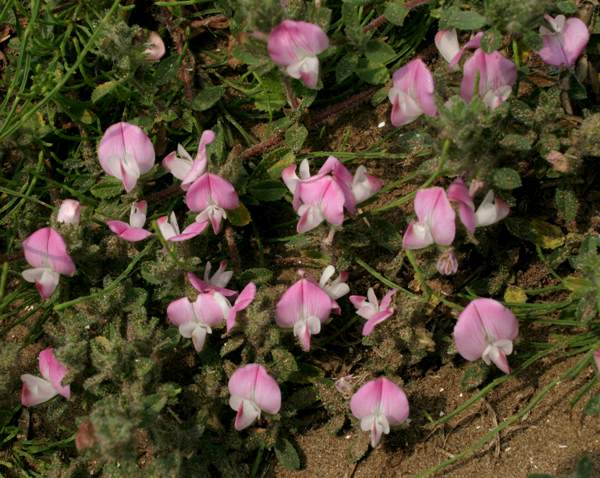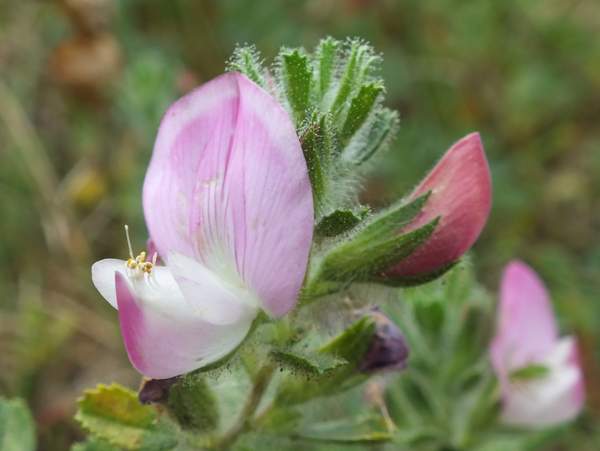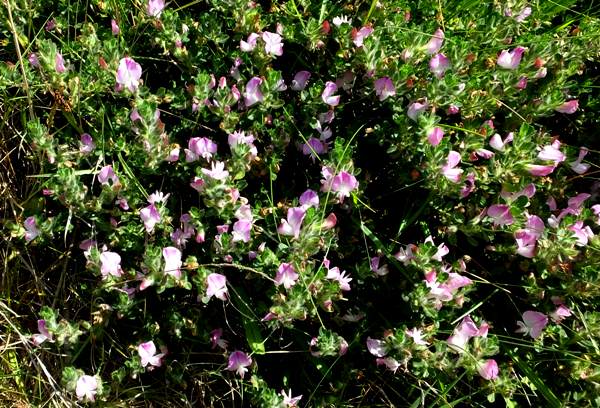Ononis repens - Common Restharrow
Phylum: Magnoliophyta - Class: Equisetopsida - Order: Fabales - Family: Fabaceae

Description
Restharrow flowers, which appear singly on short stalks at the upper leaf nodes, are pink, 1.5 to 2cm long and typically pea-like; they are hermaphrodite (having both male and female parts). The tough stems are hairy, sometimes with a few soft spines, and the sticky, hairy leaves are oval-trefoil, generally with just very slight notching.
This prostrate perennial plant, which spreads mainly via underground rhizomes, rarely grows more than 50cm tall. Common Restharrow has a spread that is often more than twice its height.
Distribution
This lovely plant, which some authorities now prefer to refer to as Ononis spinosa subsp. procurrens (Wallr.) Briq., is restricted to calcarous soils but is fairly widespread throughout most of Britain except north-west Scotland and occurs also in Ireland, mainly on the coastal fringes of the south east.

Habitat
A member of the Pea family, Common Restharrow commonly grows on dry grassy coastal cliffs but can also be found inland on some roadside verges and in dry grassland on chalk or limestone-rich soils. This is one of the larval foodplants of the Common Blue butterfly. Being a member of the pea family Fabaceae, Restharrow has nitrogen-fixing bacteria within its root nodules.
Blooming times
Common Restharrow can usually be seen in flower from June though until late September.

Etymology
The genus name Ononis is thought to come from the ancient Greek word Onos meaning a donkey; in ancient times it seems that this plant was used as a source of fodder for donkeys. The specific epithet repens comes from Latin and means creeping - a reference to the prostrate nature of the plant.
The common name Restharrow comes from this plant's woody roots, which were tough enough to stop (or to 'arrest') horse-drawn implements and, in particular, harrows.

Uses
The roots of this plant contain a substance that tastes very like liquorice, and in the past Restharrow roots were used to make a kind of tea that was thought to be useful for treating kidney disorders. (An urgent visit to the qualified physician would be our advice!)
The pictures shown on this page were taken at Kenfig National Nature Reserve in South Wales in early July and near Llandudno, north Wales, in mid July.
Sue Parker's latest ebook is a revised and enlarged edition of Wild Orchids in The Burren. Full details here...
Buy it for just £5.95 on Amazon...
Please Help Us: If you have found this information interesting and useful, please consider helping to keep First Nature online by making a small donation towards the web hosting and internet costs.
Any donations over and above the essential running costs will help support the conservation work of Plantlife, the Rivers Trust and charitable botanic gardens - as do author royalties and publisher proceeds from books by Pat and Sue.

